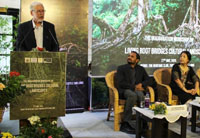
Junhi Han, Chief of the Culture Unit at the UNESCO South Asia, graced
News Alliance
REGIONAL, May 27, 2025: A workshop on the Living Root Bridges Cultural Landscape was held Tuesday at the Heritage Club in the historic Tripura Castle, Shillong. The event was organized by the Department of Arts and Culture, Government of Meghalaya, in collaboration with UNESCO, INTACH and the Meghalaya Basin Management Agency (MBMA).
Principal Secretary, Forest and Environment Department Sampath Kumar highlighted that the initiative was originally envisioned by Chief Minister Conrad Sangma, who expressed a strong commitment to bring UNESCO's focus to the unique living root bridges and assured dedicated funding for the project.
Kumar noted that several research efforts are already underway to study the bridges in depth, with the government working closely with local communities to further the initiative.
Representing UNESCO Junhi Han, Chief of the Culture Unit at the UNESCO South Asia Regional Office in New Delhi, expressed gratitude to the Meghalaya government for facilitating the study of these bioengineered structures. She described the living root bridges as extraordinary examples of harmony between nature and humanity.
Han commended the state for promoting these naturally formed structures, which are not products of industrial machinery but the result of indigenous knowledge and skills passed down through generations. She stressed the importance of conserving this heritage and educating the youth on its significance.
Padma Shri awardee and former UPSC Chair Dr David R Syiemlieh, who attended the event as Chief Guest, shared his appreciation for being part of the discussion titled "Guiding the Preparation of World Heritage Nomination Dossier for Living Root Bridges."
Dr Syiemlieh emphasized the vital role the bridges play for local communities, especially in enabling river crossings. He explained that locals use bamboo and betel nut trunks to direct the roots across streams until they grow into functional footbridges.
He further stated that while some root bridges have been lost over time, many still stand today—some even over a century old. He underscored their cultural and ecological significance and noted their wide presence across the Khasi and Jaintia Hills.
The workshop marked a significant step forward in the ongoing efforts to preserve and potentially nominate the Living Root Bridges of Meghalaya for UNESCO World Heritage recognition.
https://indigenousherald.com/